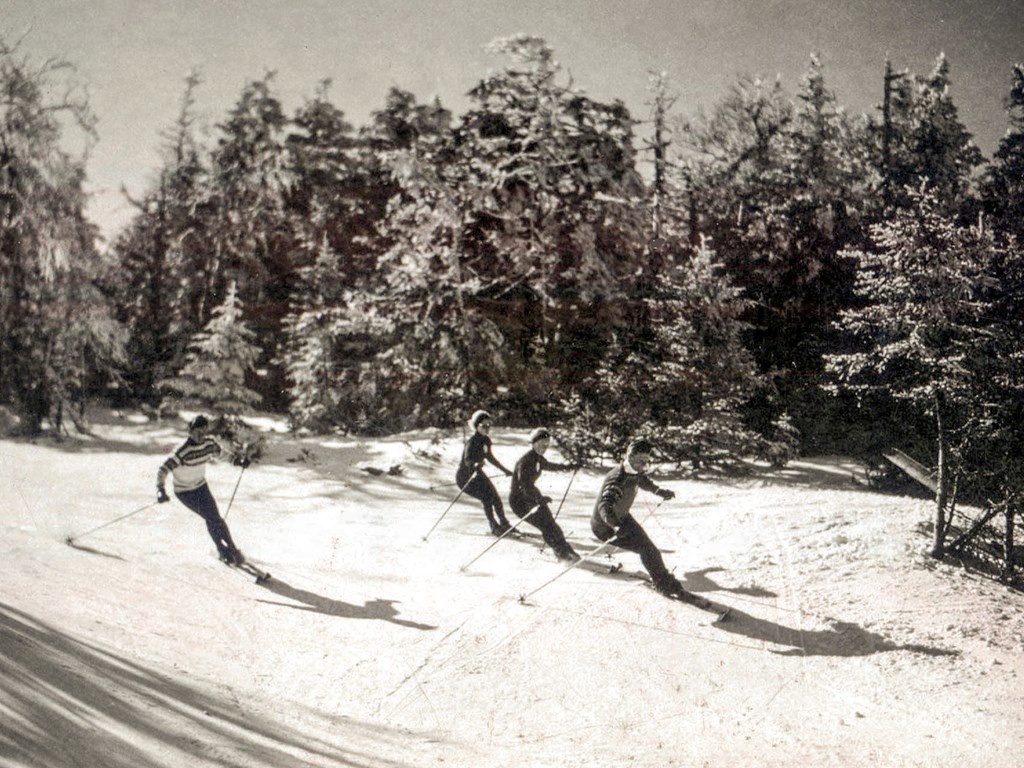*This is a multi-part series on the history of Warren, VT
*Read Part 1
*Read Part 2
Rustic skiing was known in the valley prior to World War II. The first rope tow was operated by the Warren Outing Club located on a farm owned by the Austin family.
In 1954 a former New Yorker named Damon Gadd moved into town with his wife, Sarah. After graduating from Yale University he and Sarah had migrated to Hawaii where he set up the state’s visitors bureau. Damon and Sarah had skied in Europe and envisioned a ski resort here in the valley which would offer the amenities and sophistication as those in Europe. They enlisted the help of Warren’s former town clerk and realtor, Emma Ford, in cobbleing together the current land of Sugarbush. The land included large tracts of acreage controlled by the United States Forest Service who gave them a 99 year lease. Warren residents gave the Gadds their enthusiastic support and contributed their expertise and skills to every aspect of the mountain’s development. Many became stockholders in the Sugarbush Corporation. At this stage in the development of the ski area Damon and Sarah formed a strong relationship, partnership, and friendship with a “can do, make do” man named Jack Murphy. Jack Murphy had two enlistments in World War II. the first as an instructor to the 10th Mountain Division where he taught soldiers how to ski with balance while carrying heavy backpacks and rifles Then as an Army Air Corp pilot. He was skilled, tough, and completely charming.
Damon, Sarah, and Jack planned, walked and laid out the trails on Sugarbush. The first trails were Organgrinder, Jester, Downspout and Moonshine Some say that to this day those original trails offer some of the best skiing found anywhere.
The fourth member of this team was Lixi Fortna. Damon and Jack, in seeking an office manager went to see Lixi at her farm where she was raising chickens and asked if she would be willing to run the Sugarbush office. Lixi told them she didn’t think she wanted the job because she was too embarassed to answer phones due to her Czechoslovakian accent plus the fact that she had no knowledge of bookkeeping. Their answer to her was, “Fine, you are hired.” Traveling the German Flats Road to work she often had to stop to let bears and other animals cross the one lane road.
Damon, Sarah, Jack and Lixi remained a team for over twenty years. Sugarbush was a place where everyone pitched in. Damon and Jack could be found all over the mountain doing whatever needed to be done from selling tickets to installing a lift. The first lift was a 3-seat gondola, then the longest lift in the country, and a T bar. The gondola became the symbol of Sugarbush.
Sugarbush opened on December 25, 1958. Tickets were $5.50 and at that time, due to an archaic blue law denying use of checks on Sunday, there was a lot of cash on hand Sunday night. Since there were no banks in the valley, Henry Perkins (the first full-time employee)would take the cash in a brown paper bag stuffed under the seat of his truck and drive it to Montpelier on Monday mornings. Lixi ran the office from a telephone company truck rescued from the second World War service and equipped with a crank telephone, a one arm bandit adding machine and a manual typewriter.
Peter Estin, socialite turned skier, was selected to be the Director of the Ski School and he attracted a new group of young attractive skiers. In 1959, the second year of operations, Ski Club 10 opened. This luncheon club situated on the mountain, was modeled after the Corviglia Club in St. Moritz, and its founding members were socially prominent men and women who’s association with Sugarbush helped spread the word Both the designer Oleg Cassini and his brother Igor were members. Cassini coined the term “jet set” for the New Yorkers who flew to Vermont and Sugarbush for the weekend. Orsini’s of New York opened the first restaurant complete with crystal chandeliers and glamour. (the site of The CommonMan)
Sugarbush was known as Mascara Mountain for its ties with the Manhattanites who made up the “60s” ski scene there. The Gadd days were truly memorable and when the legendary Stein Eriksen took over the ski school from Peter Estin the glamour of this Vermont resort reached new heights. Damon and Jack wanted a name and there was none to compare with Stein’s. He was a ski god with two Olympic medals and three World championship golds and with his blond hair, killer blue eyes and what can only be called magnificent technique he was the epitome of perfection for any skier. He directed the ski school at Sugarbush for 4 years before being lured away to Aspen.
Stein added to the glamor and excitement of Sugarbush which was now well established as the “in” place to go. Writers, magazine editors and newspeople kept Sugarbush in the forefront of glamour places. Second homes and inns were built to accommodate skiers. Buses were chartered in New York where guests were picked up on Park Avenue and wined and dined en route to Sugarbush
Stein’s legacy at Sugarbush is a double black diamond run that drops for almost a half-mile down Gadd Peak and bears his name. On a dare from Jack Murphy, Stein designed the trail that bears his name and is the one of Sugarbush’s most revered runs. When Stein left Sigi Grottendorfer, originally from Salzburg, Austria took over as Ski meister and remained at Sugarbush until 1987 bridging the gap when the Gadds retired to Florida in 1978 and the new owner of Sugarbush, Roy Cohen, took over. A new era at Sugarbush began.

